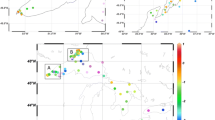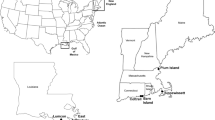Abstract
The primary objective of this study was to gain an understanding of how key microbial communities involved in nitrogen cycling in estuarine sediments vary over a 12-month period. Furthermore, we sought to determine whether changes in the size of these communities are related to, or indicative of, seasonal patterns in fixed nitrogen dynamics in Elkhorn Slough—a small, agriculturally impacted estuary with a direct connection to Monterey Bay. We assessed sediment and pore water characteristics, abundance of functional genes for nitrification (bacterial and archaeal amoA, encoding ammonia monooxygenase subunit A) and denitrification (nirS and nirK, encoding nitrite reductase), and measurements of potential nitrification and denitrification activities at six sites. No seasonality in the abundance of denitrifier or ammonia oxidizer genes was observed. A strong association between potential nitrification activity and the size of ammonia-oxidizing bacterial communities was observed across the estuary. In contrast, ammonia-oxidizing archaeal abundances remained relatively constant in space and time. Unlike many other estuaries, salinity does not appear to regulate the distribution of ammonia-oxidizing communities in Elkhorn Slough. Instead, their distributions appear to be governed over two different time scales. Long-term niche characteristics selected for the gross size of archaeal and bacterial ammonia-oxidizing communities, yet covariation in their abundances between monthly samples suggests that they respond in a similar manner to short-term changes in their environment. Abundances of denitrifier and ammonia oxidizer genes also covaried, but site-specific differences in this relationship suggest differing levels of interaction (or coupling) between nitrification and denitrification.





Similar content being viewed by others
References
Seitzinger SP, Nixon SW (1985) Eutrophication and the rate of denitrification and N2O production in coastal marine sediments. Limnol Oceanogr 30:1332–1339
Ryther JH, Dunstan WM (1971) Nitrogen, phosophorous, and eutrophication in the coastal marine environment. Science 171:1008–1013
Rabalais N, Nixon S (2002) Preface: nutrient overenrichment of the coastal zone. Estuaries 25:639
An S, Joye SB (2001) Enhancement of coupled nitrification-denitrification by benthic photosynthesis in shallow estuarine sediments. Limnol Oceanogr 46:62–74
Crowe SA, Canfield DE, Mucci A et al (2011) Anammox, denitrification and fixed-nitrogen removal in sediments of the Lower St. Lawrence Estuary. Biogeosci Discuss 9:4309–4321
Smith JM, Casciotti KL, Chavez FP, Francis CA (2014) Differential contributions of archaeal ammonia oxidizer ecotypes to nitrification in coastal surface waters. ISME J 1–11. doi: 10.1038/ismej.2014.11
Leininger S, Urich T, Schloter M et al (2006) Archaea predominate among ammonia-oxidizing prokaryotes in soils. Nature 442:806–809. doi:10.1038/nature04983
Beman JM, Popp BN, Francis CA (2008) Molecular and biogeochemical evidence for ammonia oxidation by marine Crenarchaeota in the Gulf of California. ISME J 2:429–441. doi:10.1038/ismej.2007.118
Mosier AC, Francis CA (2008) Relative abundance and diversity of ammonia-oxidizing archaea and bacteria in the San Francisco Bay estuary. Environ Microbiol 10:3002–3016
Santoro AE, Francis CA, de Sieyes NR, Boehm AB (2008) Shifts in the relative abundance of ammonia-oxidizing bacteria and archaea across physicochemical gradients in a subterranean estuary. Environ Microbiol 10:1068–1079. doi:10.1111/j.1462-2920.2007.01547.x
Magalhães C, Machado A, Bordalo A (2009) Temporal variability in the abundance of ammonia-oxidizing bacteria vs. archaea in sandy sediments of the Douro River estuary, Portugal. Aquat Microb Ecol 56:13–23. doi:10.3354/ame01313
Caffrey JM, Bano N, Kalanetra K, Hollibaugh JT (2007) Ammonia oxidation and ammonia-oxidizing bacteria and archaea from estuaries with differing histories of hypoxia. ISME J 1:660–662. doi:10.1038/ismej.2007.79
Moin NS, Nelson KA, Bush A, Bernhard AE (2009) Distribution and diversity of archaeal and bacterial ammonia oxidizers in salt marsh sediments. Appl Environ Microbiol 75:7461–7468
Bernhard AE, Bollmann A (2010) Estuarine, coastal and shelf science. Estuar Coast Shelf Sci 88:1–11. doi:10.1016/j.ecss.2010.01.023
Zumft WG (1997) Cell biology and molecular basis of denitrification. Microbiol Molec Biol Rev 61:533–616
Smith JM, Ogram A (2008) Genetic and functional variation in denitrifier populations along a short-term restoration chronosequence. Appl Environ Microbiol 74:5615–5620
Mosier AC, Francis CA (2010) Denitrifier abundance and activity across the San Francisco Bay estuary. Environ Microbiol Rep 2:667–676
Chapin T, Caffrey J, Jannasch H (2004) Nitrate sources and sinks in Elkhorn Slough, California: results from long-term continuous in situ nitrate analyzers. Estuaries Coasts 27:882–894
Caffrey JM, Chapin TP, Jannasch HW, Haskins JC (2007) High nutrient pulses, tidal mixing and biological response in a small California estuary: variability in nutrient concentrations from decadal to hourly time scales. Estuar Coast Shelf Sci 71:368–380
Nidzieko NJ, Monismith SG (2012) Contrasting seasonal and fortnightly variations in the circulation of a seasonally inverse estuary, Elkhorn Slough, California. Estuaries Coasts 36:1–17. doi:10.1007/s12237-012-9548-1
Breaker LC, Broenkow WW, Watson WE, Jo Y-H (2007) Tidal and nontidal oscillations in Elkhorn Slough, CA. Estuaries Coasts 31:239–257. doi:10.1007/s12237-007-9021-8
Nidzieko NJ, Hench JL, Monismith SG (2009) Lateral circulation in well-mixed and stratified estuarine flows with curvature. J Phys Oceanogr 39:831–851. doi:10.1175/2008JPO4017.1
Largier JL, Hollibaugh JT, Smith SV (1997) Seasonally hypersaline estuaries in Mediterranean-climate regions. Estuar Coast Shelf Sci 45:789–797
Breier JA, Nidzieko N, Monismith S (2009) Tidally regulated chemical fluxes across the sediment-water interface in Elkhorn Slough, California: evidence from a coupled geochemical and hydrodynamic approach. Limnol Oceanogr 56:1964–1980
Francis CA, Roberts KJ, Beman JM et al (2005) Ubiquity and diversity of ammonia-oxidizing archaea in water columns and sediments of the ocean. Proc Natl Acad Sci U S A 102:14683–14688
Stephen JR, Chang YJ, Macnaughton SJ et al (1999) Effect of toxic metals on indigenous soil β-subgroup proteobacterium ammonia oxidizer community structure and protection against toxicity by inoculated metal-resistant bacteria. Appl Environ Microbiol 65:95–101
Rotthauwe JH, Witzel KP, Liesack W (1997) The ammonia monooxygenase structural gene amoA as a functional marker: molecular fine-scale analysis of natural ammonia-oxidizing populations. Appl Environ Microbiol 63:4704–4712
Ludwig W, Strunk O, Westram R et al (2004) ARB: a software environment for sequence data. Nuc Acids Res 32:1363–1371
Schloss PD, Westcott SL, Ryabin T et al (2009) Introducing mothur: open-source, platform-independent, community-supported software for describing and comparing microbial communities. Appl Environ Microbiol 75:7537–7541
Henry S, Baudoin E, López-Gutiérrez JC (2004) Quantification of denitrifying bacteria in soils by nirK gene targeted real-time PCR. J Microbiol Methods 59:327–335
Braker G, Fesefeldt A, Witzel KP (1998) Development of PCR primer systems for amplification of nitrite reductase genes (nirK and nirS) to detect denitrifying bacteria in environmental samples. Appl Environ Microbiol 64:3769–3775
Caffrey JM, Harrington N, Ward BB (2002) Biogeochemical processes in a small California estuary. 1. Benthic fluxes and pore water constituents reflect high nutrient freshwater inputs. Mar Ecol Prog Ser 233:39–53
Caffrey J, Harrington N, Solem I, Ward BB (2003) Biogeochemical processes in a small California estuary. 2. Nitrification activity, community structure and role in nitrogen budgets. Mar Ecol Prog Ser 248:27–40
Harrison J, Matson P (2003) Patterns and controls of nitrous oxide emissions from waters draining a subtropical agricultural valley. Glob Biogeochem Cycles 17:1080
Sørensen J (1978) Denitrification rates in a marine sediment as measured by the acetylene inhibition technique. Appl Environ Microbiol 36:139–143
Verardo DJ, Froelich PN, McIntyre A (1990) Determination of organic carbon and nitrogen in marine sediments using the Carlo Erba NA-1500 analyzer. Deep-Sea Res Pt I 37:157–165
Herrmann M, Saunders AM, Schramm A (2008) Archaea dominate the ammonia-oxidizing community in the rhizosphere of the freshwater macrophyte Littorella uniflora. Appl Environ Microbiol 74:3279–3283
Reed DW, Smith JM, Francis CA, Fujita Y (2010) Responses of ammonia-oxidizing bacterial and archaeal populations to organic nitrogen amendments in low-nutrient groundwater. Appl Environ Microbiol 76:2517–2523
Abell GCJ, Revill AT, Smith C et al (2009) Archaeal ammonia oxidizers and nirS-type denitrifiers dominate sediment nitrifying and denitrifying populations in a subtropical macrotidal estuary. ISME J 4:286–300. doi:10.1038/ismej.2009.105
Dang H, Li J, Chen R et al (2010) Diversity, abundance, and spatial distribution of sediment ammonia-oxidizing Betaproteobacteria in response to environmental gradients and coastal eutrophication in Jiaozhou Bay, China. Appl Environ Microbiol 76:4691–4702. doi:10.1128/AEM.02563-09
Smith CJ, Nedwell DB, Dong LF, Osborn AM (2007) Diversity and abundance of nitrate reductase genes (narG and napA), nitrite reductase genes (nirS and nrfA), and their transcripts in estuarine sediments. Appl Environ Microbiol 73:3612–3622
Kassen R, Buckling A, Bell G, Rainey PB (2000) Diversity peaks at intermediate productivity in a laboratory microcosm. Nature 406:508–512
Beman JM, Chow C-E, King AL et al (2011) Global declines in oceanic nitrification rates as a consequence of ocean acidification. Proc Natl Acad Sci U S A 108:208–213
Kitidis V, Laverock B, McNeill LC et al (2011) Impact of ocean acidification on benthic and water column ammonia oxidation. Geophys Res Lett 38:L21603. doi:10.1029/2011GL049095
Bouskill NJ, Tang J, Riley WJ, Brodie EL (2012) Trait-based representation of biological nitrification: model development, testing, and predicted community composition. Front Microbiol. doi:10.3389/fmicb.2012.00364
Rysgaard S, Thastum P, Dalsgaard T et al (1999) Effects of salinity on NH4 + adsorption capacity, nitrification, and denitrification in danish estuarine sediments. Estuaries 22:21. doi:10.2307/1352923
Bernhard AE, Tucker J, Giblin AE, Stahl DA (2007) Functionally distinct communities of ammonia-oxidizing bacteria along an estuarine salinity gradient. Environ Microbiol 9:1439–1447
Francis CA, O’Mullan GD, Ward BB (2003) Diversity of ammonia monooxygenase (amoA) genes across environmental gradients in Chesapeake Bay sediments. Geobiology 1:129–140. doi:10.1046/j.1472-4669.2003.00010.x
Koops H-P, Pommerening-RÃ ser A (2006) Distribution and ecophysiology of the nitrifying bacteria emphasizing cultured species. FEMS Microbiol Ecol 37:1–9. doi:10.1111/j.1574-6941.2001.tb00847.x
Rocha C (1998) Rhythmic ammonium regeneration and flushing in intertidal sediments of the Sado estuary. Limnol Oceanogr 43:823–831
Koop-Jakobsen K, Giblin A (2002) Tidal flushing of ammonium from intertidal salt marsh sediments: the relative importance of adsorbed ammonium. Biolog Bull 203:258–259
Gubry-Rangin C, Hai B, Quince C et al (2011) Niche specialization of terrestrial archaeal ammonia oxidizers. Proc Natl Acad Sci U S A 108:21206–21211
Jenkins MC, Kemp WM (1984) The coupling of nitrification and denitrification in two estuarine sediments. Limnol Oceanogr 29:609–619
Jensen K, Sloth NP, Risgaard-Petersen N et al (1994) Estimation of nitrification and denitrification from microprofiles of oxygen and nitrate in model sediment systems. Appl Environ Microbiol 60:2094–2100
Acknowledgments
The authors would like to thank Darcy McRose, Helen Chen, Alyson Santoro, Daniel Keymer, Nicholas Nidzieko, Nate Clark, and Angela Primavera for the assistance with sample collection and data acquisition. This work was supported in part by National Science Foundation grants MCB-0604270 and OCE-0847266 to C.A.F.
Author information
Authors and Affiliations
Corresponding author
Additional information
The nucleotide sequence data reported are available in the DDBJ/EMBL/GenBank databases under the accession number(s) JX232628-JX233422.
Electronic supplementary material
Below is the link to the electronic supplementary material.
ESM 1
(DOCX 244 kb)
Rights and permissions
About this article
Cite this article
Smith, J.M., Mosier, A.C. & Francis, C.A. Spatiotemporal Relationships Between the Abundance, Distribution, and Potential Activities of Ammonia-Oxidizing and Denitrifying Microorganisms in Intertidal Sediments. Microb Ecol 69, 13–24 (2015). https://doi.org/10.1007/s00248-014-0450-1
Received:
Accepted:
Published:
Issue Date:
DOI: https://doi.org/10.1007/s00248-014-0450-1




